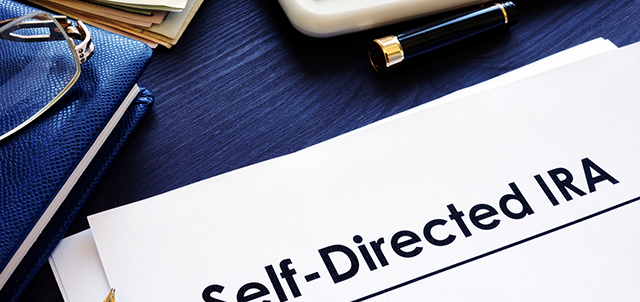Investor Alert: Self-Directed IRAs and the Risk of Fraud

The SEC’s Office of Investor Education and Advocacy, the North American Securities Administrators Association (NASAA), and the Financial Industry Regulatory Authority (FINRA) are updating this Investor Alert to warn investors of potential risks associated with self-directed Individual Retirement Accounts (self-directed IRAs). Self-directed IRAs allow investment in a broader—and potentially riskier—portfolio of assets than other types of IRAs. Those assets may include real estate, private placement securities, precious metals and other commodities, and crypto assets. Investors should be mindful that investing through self-directed IRAs raises risks, including fraudulent schemes, high fees and volatile performance.
Investing Through Self-Directed IRAs
An Individual Retirement Account (IRA) provides investors with tax benefits for retirement savings. Some common examples of IRAs include the traditional IRA, Roth IRA, Simplified Employee Pension (SEP) IRA, and Savings Incentive Match Plan for Employees (SIMPLE) IRA. All IRA accounts are held for investors by custodians, which may include banks, trust companies, or any other entity approved by the Internal Revenue Service (IRS) to act as an IRA custodian.
A self-directed IRA is an IRA held by a custodian that allows investment in a broader set of assets than most IRA custodians permit. Custodians for self-directed IRAs may allow investors to invest retirement funds in “alternative assets” such as real estate, precious metals and other commodities, crypto assets, private placement securities, promissory notes, and tax lien certificates. Investments in these kinds of assets have unique risks that investors should consider. Those risks can include a lack of information and liquidity—and the risk of fraud.
Self-Directed IRA Risks
While all investments have risk, self-directed IRAs have some risks that differ from those involved with IRAs offered by registered broker-dealers and investment advisers. These risks include a lack of legal and regulatory protection and a heightened risk of fraud, particularly when investing in alternative assets.
No Review – With a self-directed IRA, you have sole responsibility for evaluating and understanding the investments in the account. Due to federal laws and regulatory rules related to selling investment products or providing investment advice, most custodians for other types of IRAs limit the holdings in IRA accounts to firm-approved stocks, bonds, mutual funds, and CDs. However, these limitations do not apply to self-directed IRAs. Self-directed IRA custodians:
DO NOT sell investment products or provide investment advice;
DO NOT evaluate the quality or legitimacy of any investment in the self-directed IRA or its promoters; and
DO NOT verify the accuracy of any financial information that is provided for an investment in the account.
Self-directed IRA custodians are only responsible for holding and administering the assets in the account. Furthermore, most custodial agreements between a self-directed IRA custodian and an investor explicitly state that the self-directed IRA custodian has no responsibility for investment performance. For additional information on self-directed IRA custodians, read NASAA’s Investor Bulletin “Are you an informed investor? Third-Party Custodians of Self-Directed IRAs and Other Qualified Plans.”
Self-directed IRA promoters are individuals or companies that promote and solicit money from investors for self-directed IRA investments. Promoters might not be licensed investment professionals and might not be subject to the same regulatory oversight and investor protection rules that govern the securities industry. Promoters might be IRA custodians, or they might be affiliated with one or more self-directed IRA custodians. Make sure you use the resources discussed in the “Ways to Avoid Fraud with Self-Directed IRAs” section of this Investor Alert to investigate thoroughly any promoter’s background before considering any investment the promoter might offer you.
Lack of Information and Liquidity – Self-directed IRAs allow you to hold alternative investments that, unlike publicly traded securities, may only provide limited disclosures, financial and otherwise. Even when financial information for these alternative investments is available, it might not be audited by a public accounting firm. As noted above, self-directed IRA custodians usually do not check the accuracy of any financial information that is provided for an investment in the account. In addition, alternative investments might also lack liquidity either because of extended holding periods, restrictions on redemptions, limited markets or some combination of these factors. This can make it difficult for you to easily sell these investments when you want to, including when you retire or when you have to take required minimum distributions.
Crypto Assets. Some self-directed IRAs may allow you to invest in “crypto assets” such as “virtual currencies,” “coins” and “tokens.” Crypto assets might be securities that are offered without SEC registration or a valid exemption from registration, and they might not be accompanied by complete or accurate information to aid investors in making informed decisions. In addition, many of the trading platforms for these crypto assets refer to themselves as “exchanges,” which might give investors the misimpression that they have registered with the SEC. For more information, check out the SEC’s Crypto Assets webpage and the Divisions of Enforcement and Trading Markets’ “Statement on Potentially Unlawful Online Platforms for Trading Digital Assets.”
Fraud – Fraudsters might be more likely to exploit self-directed IRAs because custodians or trustees of these accounts may offer only limited protections. As noted above, custodians and trustees of self-directed IRAs typically do not investigate the assets or the background of the promoter. Here are some examples of how fraudsters might try to use self-directed IRAs to perpetrate a fraud on unsuspecting investors:
- Fake Custodians – Fraudsters might use a fake self-directed custodian to attempt to steal your money. Before depositing any money with a self-directed IRA custodian, make sure that the self-directed IRA custodian is legitimate. Custodians may include banks, trust companies or any entity approved by the Internal Revenue Service (IRS) to act as an IRA custodian. One resource for verifying nonbank custodians is this list on the IRS website. However, this IRS resource is not a complete list of every custodian. If a custodian does not appear on this list, you should conduct additional research into the custodian and consider consulting a licensed, unbiased investment professional or an attorney before opening an account.
Using a legitimate custodian to buy an investment DOES NOT make that investment legitimate. Fraudsters might still attempt to sell you fraudulent investments through legitimate custodians.
- Misrepresentations Regarding Custodial Responsibilities – Fraudsters sometimes misrepresent the duties of self-directed IRA custodians to deceive investors into believing that their investments are legitimate or protected against losses. For example, fraudsters often falsely claim or imply that self-directed IRA custodians investigate and validate any investment in a self-directed IRA.
- Exploitation of Tax-Deferred Account Characteristics – As with other IRAs, self-directed IRAs are tax-deferred accounts that carry a financial penalty for prematurely withdrawing money before the accountholder reaches a certain age. The prospect of an early withdrawal penalty might encourage an investor to take a passive approach to managing the account, which could lead to a less detailed review of account information than a managed account might receive, allowing a fraudster to perpetrate the fraud longer.
Complex Tax Rules – Investing through a self-directed IRA requires you to follow complex IRS tax rules that do not apply to other IRAs. Failure to follow these rules may result in unintended tax consequences such as extra taxes, financial penalties or even loss of the account’s tax deferred status. Consult with a tax advisor before investing through a self-directed IRA to confirm that any potential investment or investment strategy follows these IRS rules. More information about these tax rules can be found here on the IRS website.
Fees – Fees for self-directed IRAs may be significantly higher than those for other types of investment accounts. In addition to transaction fees, there may be account opening fees, annual account fees, administrative fees and asset specific fees in the account. These fees vary among self-directed IRA trustees and custodians. Before opening a self-directed IRA, make sure you understand these fees and how they could impact the performance of investments in your account.
Ways to Avoid Fraud with Self-Directed IRAs
There are several steps that investors can take to reduce the risk of fraud:
- Verify information in self-directed IRA account statements. Alternative investments may be illiquid and difficult to value. As a result, self-directed IRA custodians often list the value of the investment as the original purchase price, the original purchase price plus returns reported by the promoter, or a price provided by the promoter. If possible, take steps to independently verify information—such as prices and asset values—provided in account statements. This might include obtaining a valuation from an independent, third-party professional or market expert, or researching tax assessment records.
- Avoid unsolicited investment offers. Use extreme caution before investing in an unsolicited investment offer that promotes the use of a self-directed IRA. Fraudsters might attempt to lure you into transferring money from traditional IRAs and other retirement accounts into new self-directed IRAs.
- Ask questions. Always ask if the person offering the investment is registered or licensed, and if the investment itself is registered. Then check out the answers with an unbiased source, such as the SEC, FINRA or your state securities regulator. Before making any investment decisions, review the SEC’s “Five Questions to Ask Before You Invest,” for questions you should ask before making any new investments, and the SEC’s Investor Bulletin “How to Check Out Your Investment Professional,” for tips to help you research the background and history of registered investment professionals.
- Be wary of “guaranteed” returns. All investments have risk, and investors should question any so-called “guaranteed” returns. Be wary of anyone who promises that you will receive a high rate of return on your investment, especially with little or no risk. Claims such as “risk-free,” “zero risk,” “absolutely safe” and “guaranteed profit” are hallmarks of fraud.
- Consult a professional. For investment opportunities like alternative assets in self-directed IRAs, you should consider getting a second opinion from a licensed, unbiased investment professional or an attorney. This is especially important if you are opening or creating a new account outside of a traditional financial institution or investment firm. If you need help selecting an investment professional that’s right for you, check out these free resources on Investor.gov.
Recourse for Fraud Victims
If you have lost money in a fraudulent investment scheme involving a self-directed IRA or third-party custodian, or have information about one of these scams, you should:
- Report it to the SEC at www.sec.gov/tcr.
- Check out the SEC’s Resources for Victims of Securities Law Violations.
- Contact your state securities regulator. You can find links and addresses for your state regulator by visiting the North American Securities Administrators Association’s website.
You also can read the SEC’s Investor Bulletin: How Harmed Investors May Recover Money for general information on ways victims may recover money from fraudulent scams.
Additional Information
For additional information regarding IRAs, see the Internal Revenue Service’s IRA Online Resource Guide.
For additional information related to avoiding fraud, see:
- Five Questions to Ask Before You Invest
- How to Check Out Your Investment Professional
- How to Avoid Fraud
- Avoid Fraud
- Investor Insights
Visit the SEC’s website for individual investors, Investor.gov. For more tips on smart investing, visit finra.org.
Call OIEA at 1-800-732-0330, ask a question using this online form, or email the SEC at [email protected].



